Business Decision Making Assignment: Data Analysis and Reporting
VerifiedAdded on 2022/12/29
|12
|1813
|182
Homework Assignment
AI Summary
This assignment delves into various aspects of business decision-making, beginning with data analysis techniques such as calculating the mean, standard deviation, and coefficient of variance. It then explores grouped data analysis, time series versus cross-sectional data, and networking diagrams to determine critical paths. The assignment progresses to correlation and regression analysis, including the interpretation of scatter charts and regression equations. Part 2 focuses on cost analysis, including variable and fixed costs, break-even analysis, desired profit calculations, and margin of safety assessments. The assignment concludes with a comprehensive report that explains the high-low method, fixed and variable costs, and the limitations of break-even analysis, providing a well-rounded understanding of business financial decision-making.
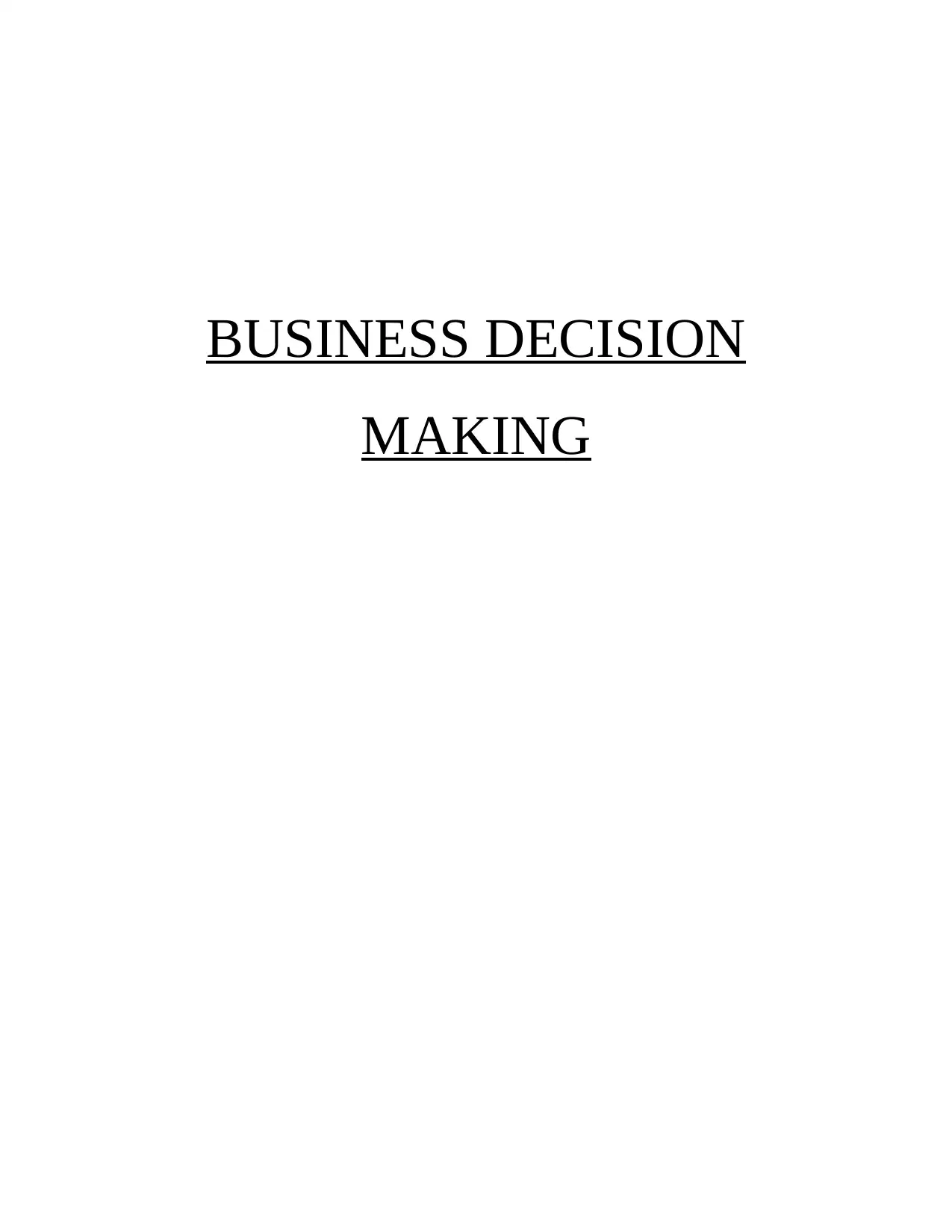
BUSINESS DECISION
MAKING
MAKING
Paraphrase This Document
Need a fresh take? Get an instant paraphrase of this document with our AI Paraphraser
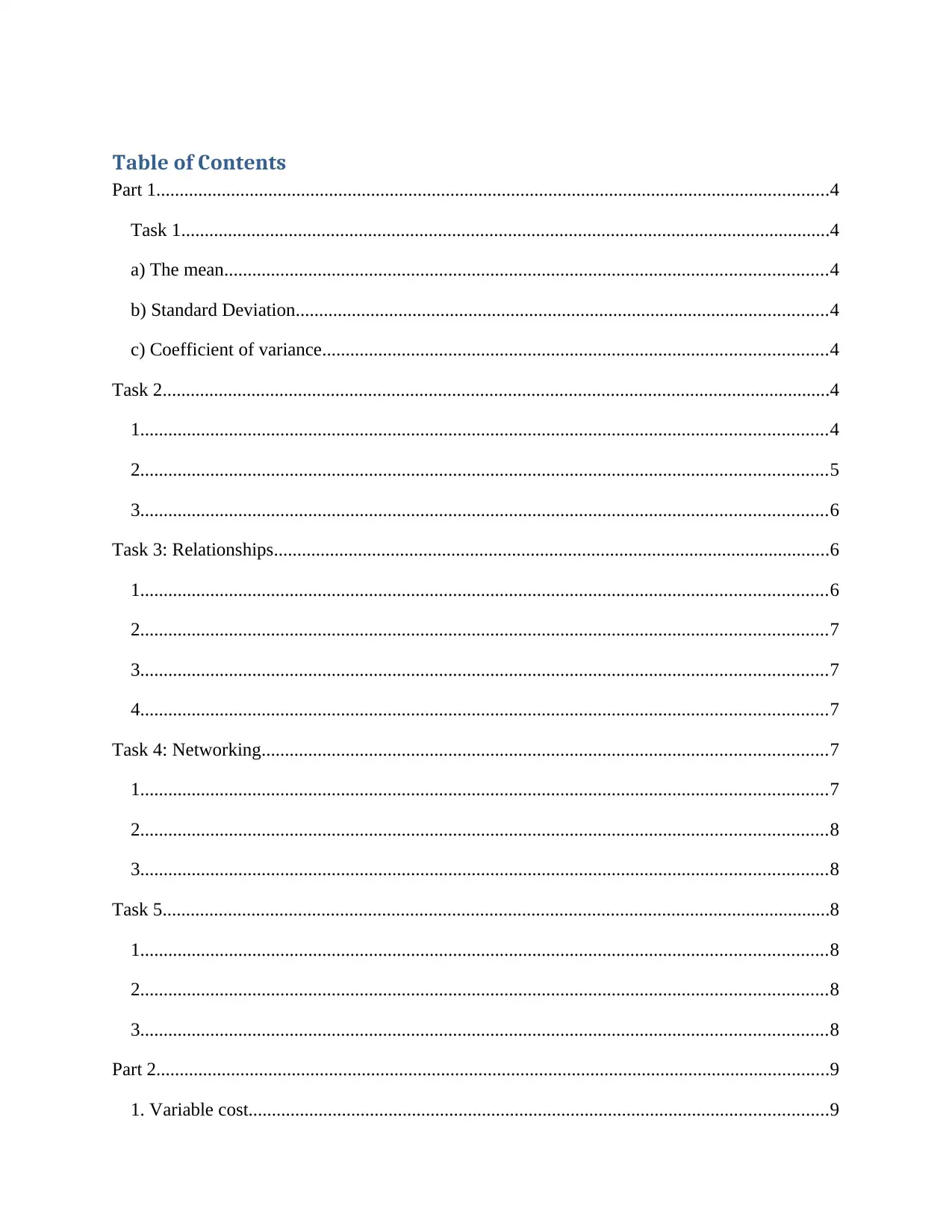
Table of Contents
Part 1................................................................................................................................................4
Task 1...........................................................................................................................................4
a) The mean.................................................................................................................................4
b) Standard Deviation..................................................................................................................4
c) Coefficient of variance............................................................................................................4
Task 2...............................................................................................................................................4
1...................................................................................................................................................4
2...................................................................................................................................................5
3...................................................................................................................................................6
Task 3: Relationships.......................................................................................................................6
1...................................................................................................................................................6
2...................................................................................................................................................7
3...................................................................................................................................................7
4...................................................................................................................................................7
Task 4: Networking.........................................................................................................................7
1...................................................................................................................................................7
2...................................................................................................................................................8
3...................................................................................................................................................8
Task 5...............................................................................................................................................8
1...................................................................................................................................................8
2...................................................................................................................................................8
3...................................................................................................................................................8
Part 2................................................................................................................................................9
1. Variable cost............................................................................................................................9
Part 1................................................................................................................................................4
Task 1...........................................................................................................................................4
a) The mean.................................................................................................................................4
b) Standard Deviation..................................................................................................................4
c) Coefficient of variance............................................................................................................4
Task 2...............................................................................................................................................4
1...................................................................................................................................................4
2...................................................................................................................................................5
3...................................................................................................................................................6
Task 3: Relationships.......................................................................................................................6
1...................................................................................................................................................6
2...................................................................................................................................................7
3...................................................................................................................................................7
4...................................................................................................................................................7
Task 4: Networking.........................................................................................................................7
1...................................................................................................................................................7
2...................................................................................................................................................8
3...................................................................................................................................................8
Task 5...............................................................................................................................................8
1...................................................................................................................................................8
2...................................................................................................................................................8
3...................................................................................................................................................8
Part 2................................................................................................................................................9
1. Variable cost............................................................................................................................9

2. Monthly fixed cost...................................................................................................................9
3. Break even...............................................................................................................................9
4. Desired profit...........................................................................................................................9
5. Margin of safety.......................................................................................................................9
6. Report....................................................................................................................................10
3. Break even...............................................................................................................................9
4. Desired profit...........................................................................................................................9
5. Margin of safety.......................................................................................................................9
6. Report....................................................................................................................................10
⊘ This is a preview!⊘
Do you want full access?
Subscribe today to unlock all pages.

Trusted by 1+ million students worldwide
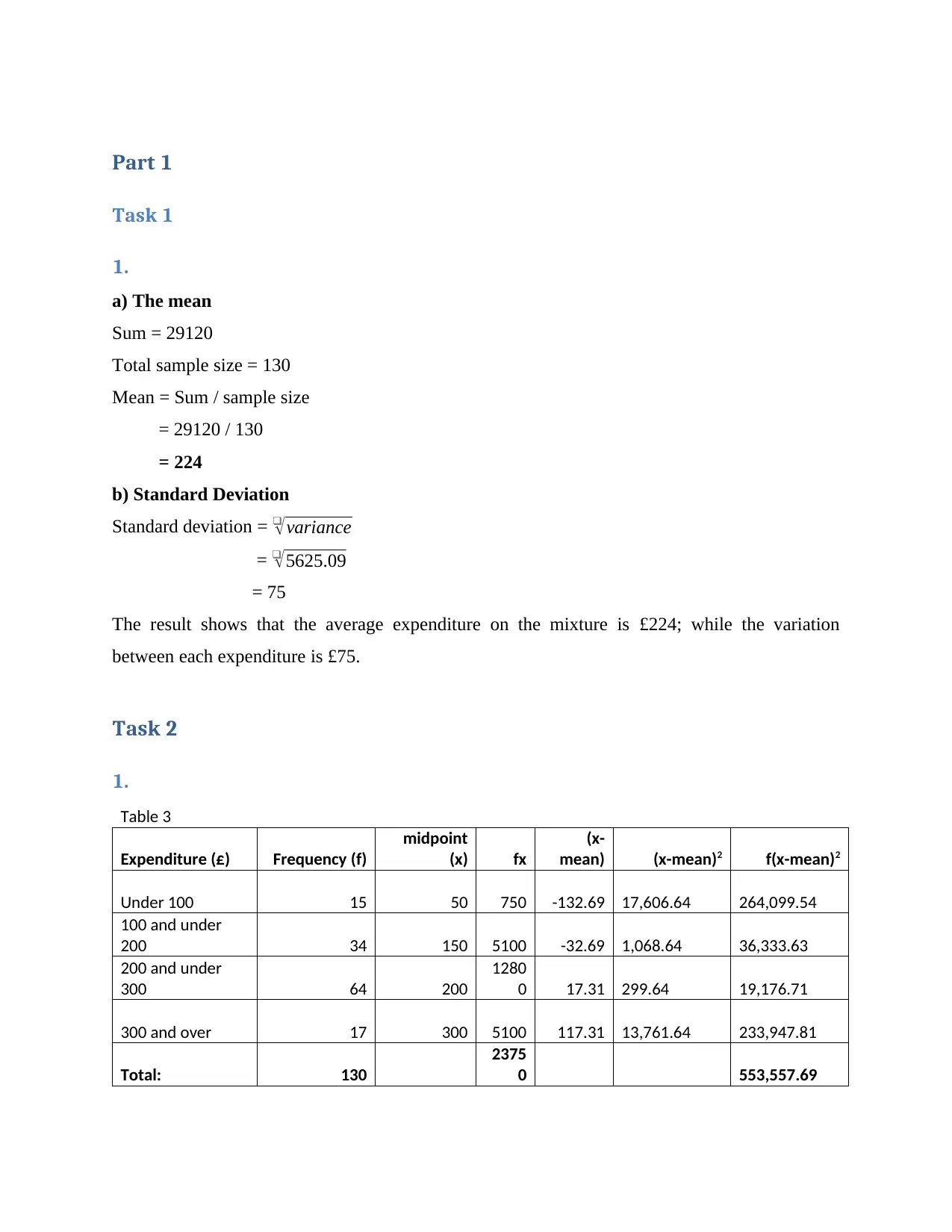
Part 1
Task 1
1.
a) The mean
Sum = 29120
Total sample size = 130
Mean = Sum / sample size
= 29120 / 130
= 224
b) Standard Deviation
Standard deviation = ❑
√ variance
= ❑
√5625.09
= 75
The result shows that the average expenditure on the mixture is £224; while the variation
between each expenditure is £75.
Task 2
1.
Table 3
Expenditure (£) Frequency (f)
midpoint
(x) fx
(x-
mean) (x-mean)2 f(x-mean)2
Under 100 15 50 750 -132.69 17,606.64 264,099.54
100 and under
200 34 150 5100 -32.69 1,068.64 36,333.63
200 and under
300 64 200
1280
0 17.31 299.64 19,176.71
300 and over 17 300 5100 117.31 13,761.64 233,947.81
Total: 130
2375
0 553,557.69
Task 1
1.
a) The mean
Sum = 29120
Total sample size = 130
Mean = Sum / sample size
= 29120 / 130
= 224
b) Standard Deviation
Standard deviation = ❑
√ variance
= ❑
√5625.09
= 75
The result shows that the average expenditure on the mixture is £224; while the variation
between each expenditure is £75.
Task 2
1.
Table 3
Expenditure (£) Frequency (f)
midpoint
(x) fx
(x-
mean) (x-mean)2 f(x-mean)2
Under 100 15 50 750 -132.69 17,606.64 264,099.54
100 and under
200 34 150 5100 -32.69 1,068.64 36,333.63
200 and under
300 64 200
1280
0 17.31 299.64 19,176.71
300 and over 17 300 5100 117.31 13,761.64 233,947.81
Total: 130
2375
0 553,557.69
Paraphrase This Document
Need a fresh take? Get an instant paraphrase of this document with our AI Paraphraser
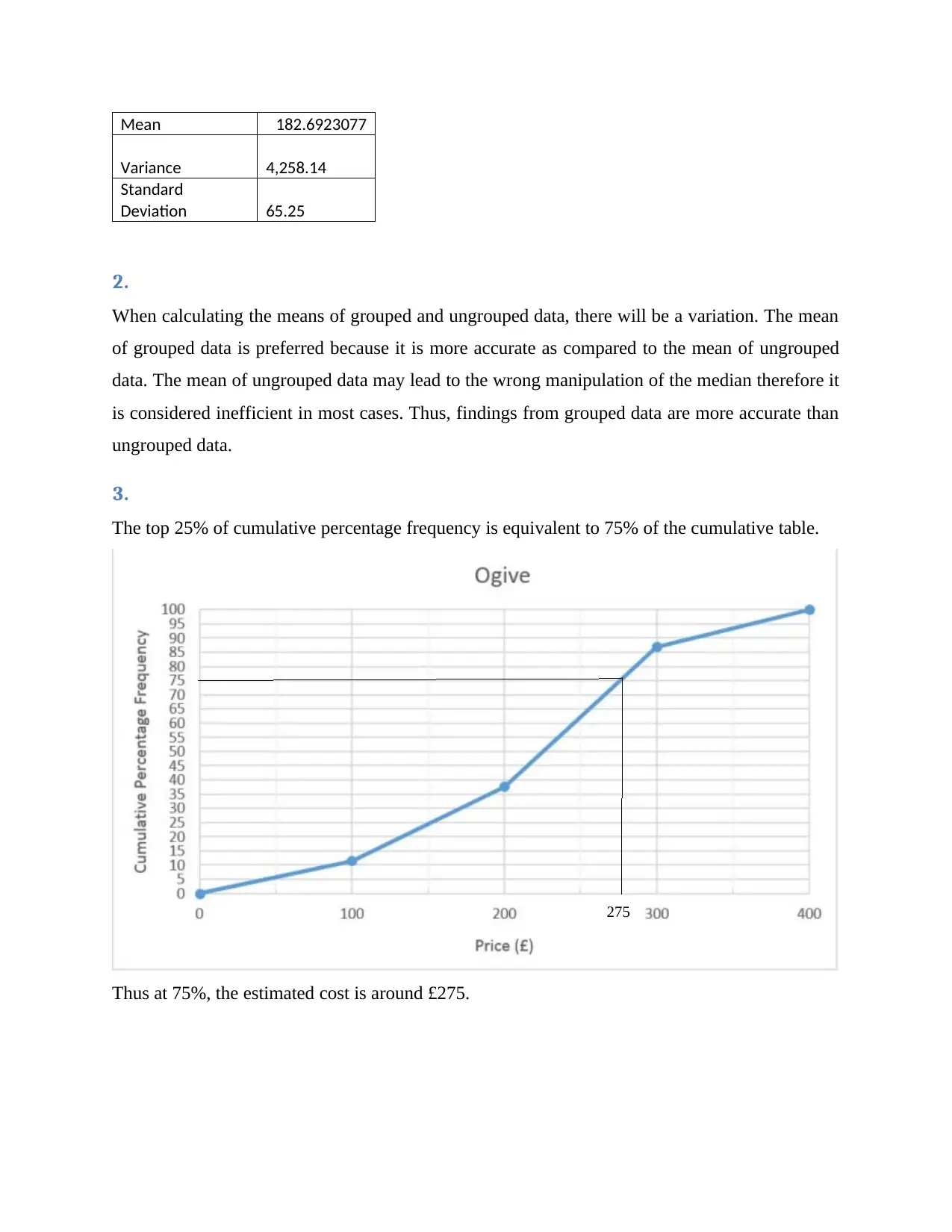
Mean 182.6923077
Variance 4,258.14
Standard
Deviation 65.25
2.
When calculating the means of grouped and ungrouped data, there will be a variation. The mean
of grouped data is preferred because it is more accurate as compared to the mean of ungrouped
data. The mean of ungrouped data may lead to the wrong manipulation of the median therefore it
is considered inefficient in most cases. Thus, findings from grouped data are more accurate than
ungrouped data.
3.
The top 25% of cumulative percentage frequency is equivalent to 75% of the cumulative table.
Thus at 75%, the estimated cost is around £275.
275
Variance 4,258.14
Standard
Deviation 65.25
2.
When calculating the means of grouped and ungrouped data, there will be a variation. The mean
of grouped data is preferred because it is more accurate as compared to the mean of ungrouped
data. The mean of ungrouped data may lead to the wrong manipulation of the median therefore it
is considered inefficient in most cases. Thus, findings from grouped data are more accurate than
ungrouped data.
3.
The top 25% of cumulative percentage frequency is equivalent to 75% of the cumulative table.
Thus at 75%, the estimated cost is around £275.
275

Task 3: Data Types
The key difference between time series and cross-sectional data is that time adjustment
information is focused on a similar variable over a while cross information is set on some factors
at the same time. Additionally, time management information includes views on a single topic at
different times, however, cross-sector information includes views on multiple topics
simultaneously in the timetable.
Areas such as Statistics, Econometrics collect and disseminate information. Information is an
essential part of exercises, for example for the study, prediction and expression of hypotheses.
Task 4: Networking
1. Network diagram
Float
ES Activity LS
EF Duration LF
0 A 5 5 C 8 8 E 13
0 5 5 5 3 8 8 5 13
5 5 1
0 B 3 3 D 4 8 F 12
5 3 8 8 1 9 9 4 13
7
0 S 0 4 G 6
0 0 0 11 2 13 13 I 17
9 13 4 17
0 H 8
9 8 17 17 J 20
17 3 20
2. Critical path
S » A » C » E » I » J = 20 days
The key difference between time series and cross-sectional data is that time adjustment
information is focused on a similar variable over a while cross information is set on some factors
at the same time. Additionally, time management information includes views on a single topic at
different times, however, cross-sector information includes views on multiple topics
simultaneously in the timetable.
Areas such as Statistics, Econometrics collect and disseminate information. Information is an
essential part of exercises, for example for the study, prediction and expression of hypotheses.
Task 4: Networking
1. Network diagram
Float
ES Activity LS
EF Duration LF
0 A 5 5 C 8 8 E 13
0 5 5 5 3 8 8 5 13
5 5 1
0 B 3 3 D 4 8 F 12
5 3 8 8 1 9 9 4 13
7
0 S 0 4 G 6
0 0 0 11 2 13 13 I 17
9 13 4 17
0 H 8
9 8 17 17 J 20
17 3 20
2. Critical path
S » A » C » E » I » J = 20 days
⊘ This is a preview!⊘
Do you want full access?
Subscribe today to unlock all pages.

Trusted by 1+ million students worldwide
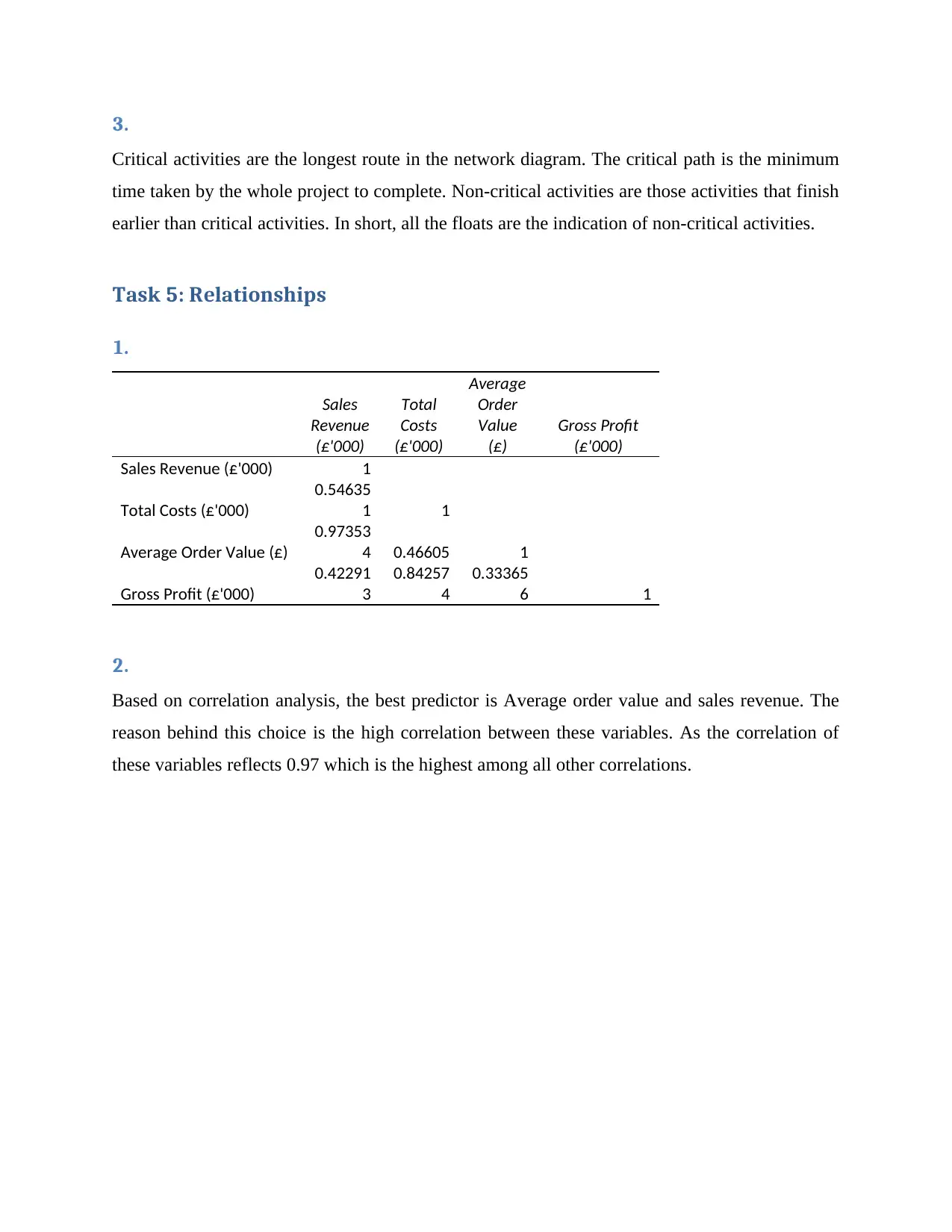
3.
Critical activities are the longest route in the network diagram. The critical path is the minimum
time taken by the whole project to complete. Non-critical activities are those activities that finish
earlier than critical activities. In short, all the floats are the indication of non-critical activities.
Task 5: Relationships
1.
Sales
Revenue
(£'000)
Total
Costs
(£'000)
Average
Order
Value
(£)
Gross Profit
(£'000)
Sales Revenue (£'000) 1
Total Costs (£'000)
0.54635
1 1
Average Order Value (£)
0.97353
4 0.46605 1
Gross Profit (£'000)
0.42291
3
0.84257
4
0.33365
6 1
2.
Based on correlation analysis, the best predictor is Average order value and sales revenue. The
reason behind this choice is the high correlation between these variables. As the correlation of
these variables reflects 0.97 which is the highest among all other correlations.
Critical activities are the longest route in the network diagram. The critical path is the minimum
time taken by the whole project to complete. Non-critical activities are those activities that finish
earlier than critical activities. In short, all the floats are the indication of non-critical activities.
Task 5: Relationships
1.
Sales
Revenue
(£'000)
Total
Costs
(£'000)
Average
Order
Value
(£)
Gross Profit
(£'000)
Sales Revenue (£'000) 1
Total Costs (£'000)
0.54635
1 1
Average Order Value (£)
0.97353
4 0.46605 1
Gross Profit (£'000)
0.42291
3
0.84257
4
0.33365
6 1
2.
Based on correlation analysis, the best predictor is Average order value and sales revenue. The
reason behind this choice is the high correlation between these variables. As the correlation of
these variables reflects 0.97 which is the highest among all other correlations.
Paraphrase This Document
Need a fresh take? Get an instant paraphrase of this document with our AI Paraphraser
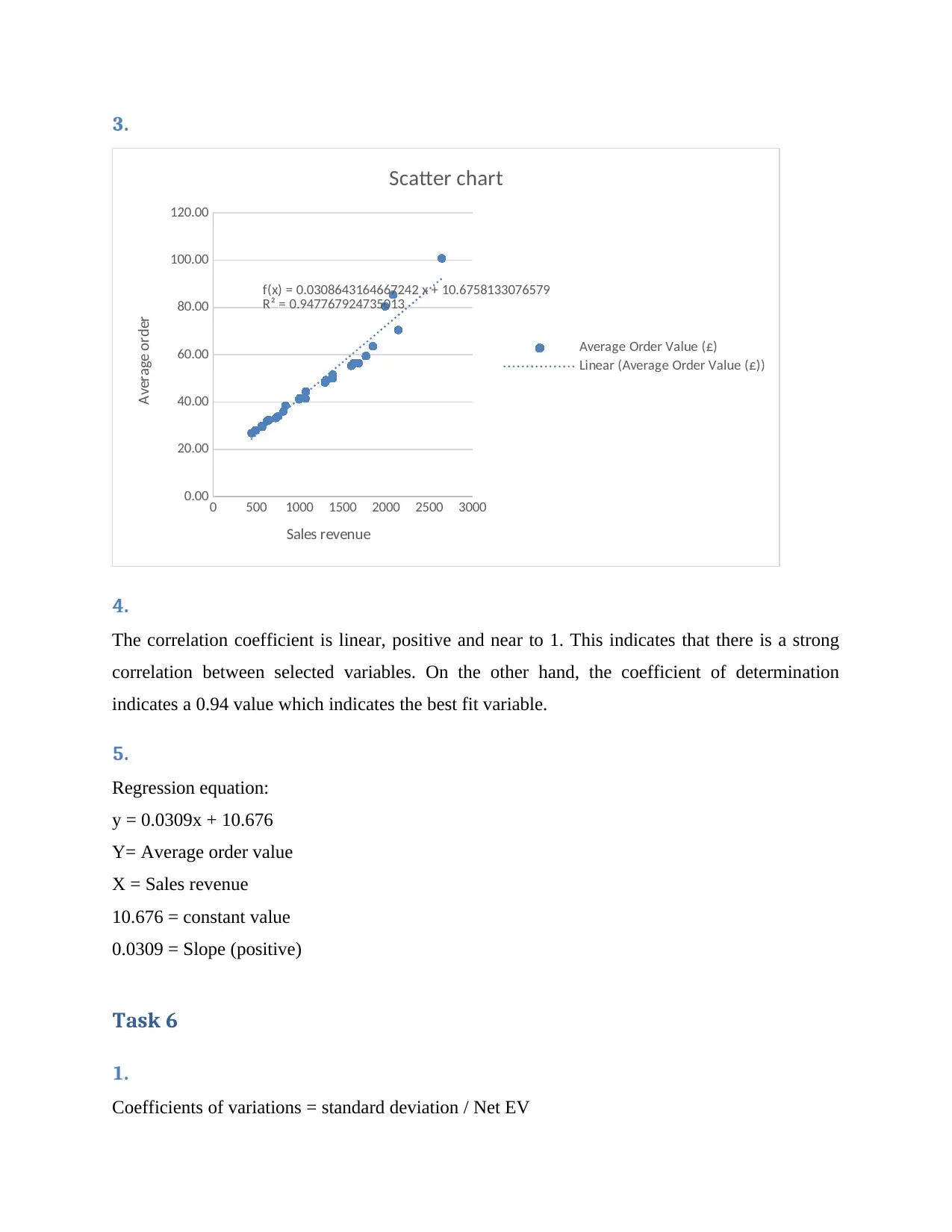
3.
0 500 1000 1500 2000 2500 3000
0.00
20.00
40.00
60.00
80.00
100.00
120.00
f(x) = 0.0308643164667242 x + 10.6758133076579
R² = 0.947767924735013
Scatter chart
Average Order Value (£)
Linear (Average Order Value (£))
Sales revenue
Average order
4.
The correlation coefficient is linear, positive and near to 1. This indicates that there is a strong
correlation between selected variables. On the other hand, the coefficient of determination
indicates a 0.94 value which indicates the best fit variable.
5.
Regression equation:
y = 0.0309x + 10.676
Y= Average order value
X = Sales revenue
10.676 = constant value
0.0309 = Slope (positive)
Task 6
1.
Coefficients of variations = standard deviation / Net EV
0 500 1000 1500 2000 2500 3000
0.00
20.00
40.00
60.00
80.00
100.00
120.00
f(x) = 0.0308643164667242 x + 10.6758133076579
R² = 0.947767924735013
Scatter chart
Average Order Value (£)
Linear (Average Order Value (£))
Sales revenue
Average order
4.
The correlation coefficient is linear, positive and near to 1. This indicates that there is a strong
correlation between selected variables. On the other hand, the coefficient of determination
indicates a 0.94 value which indicates the best fit variable.
5.
Regression equation:
y = 0.0309x + 10.676
Y= Average order value
X = Sales revenue
10.676 = constant value
0.0309 = Slope (positive)
Task 6
1.
Coefficients of variations = standard deviation / Net EV
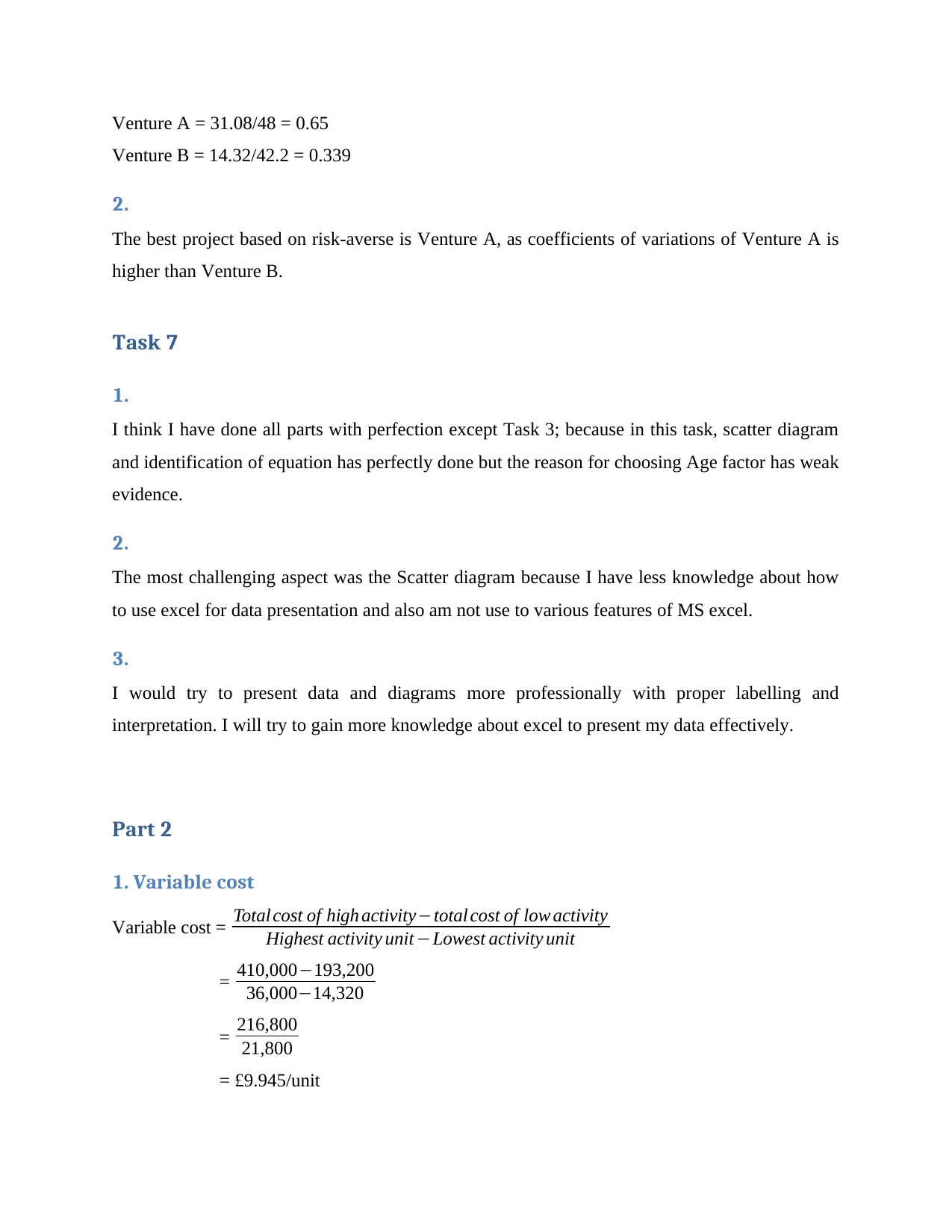
Venture A = 31.08/48 = 0.65
Venture B = 14.32/42.2 = 0.339
2.
The best project based on risk-averse is Venture A, as coefficients of variations of Venture A is
higher than Venture B.
Task 7
1.
I think I have done all parts with perfection except Task 3; because in this task, scatter diagram
and identification of equation has perfectly done but the reason for choosing Age factor has weak
evidence.
2.
The most challenging aspect was the Scatter diagram because I have less knowledge about how
to use excel for data presentation and also am not use to various features of MS excel.
3.
I would try to present data and diagrams more professionally with proper labelling and
interpretation. I will try to gain more knowledge about excel to present my data effectively.
Part 2
1. Variable cost
Variable cost = Total cost of high activity−total cost of low activity
Highest activity unit −Lowest activity unit
= 410,000−193,200
36,000−14,320
= 216,800
21,800
= £9.945/unit
Venture B = 14.32/42.2 = 0.339
2.
The best project based on risk-averse is Venture A, as coefficients of variations of Venture A is
higher than Venture B.
Task 7
1.
I think I have done all parts with perfection except Task 3; because in this task, scatter diagram
and identification of equation has perfectly done but the reason for choosing Age factor has weak
evidence.
2.
The most challenging aspect was the Scatter diagram because I have less knowledge about how
to use excel for data presentation and also am not use to various features of MS excel.
3.
I would try to present data and diagrams more professionally with proper labelling and
interpretation. I will try to gain more knowledge about excel to present my data effectively.
Part 2
1. Variable cost
Variable cost = Total cost of high activity−total cost of low activity
Highest activity unit −Lowest activity unit
= 410,000−193,200
36,000−14,320
= 216,800
21,800
= £9.945/unit
⊘ This is a preview!⊘
Do you want full access?
Subscribe today to unlock all pages.

Trusted by 1+ million students worldwide
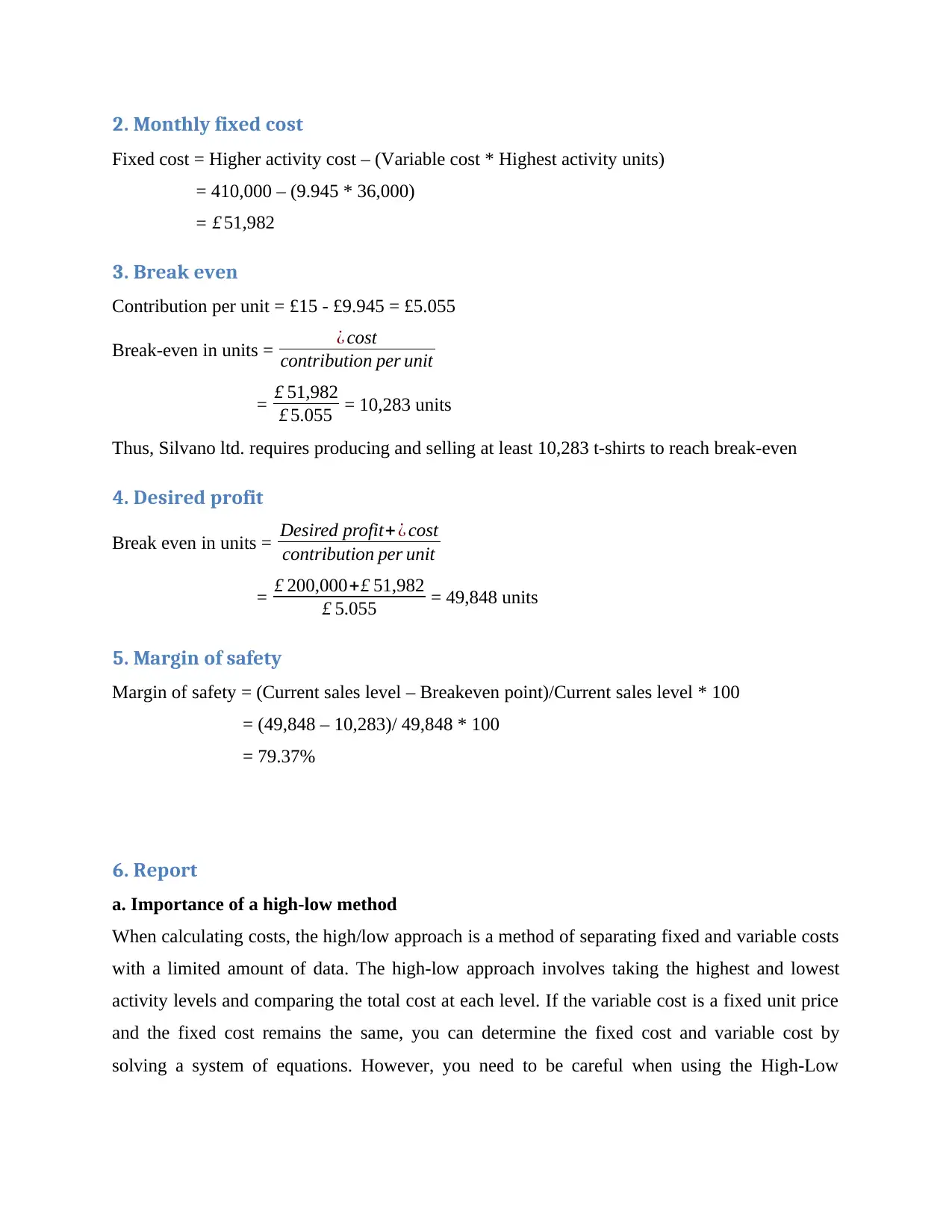
2. Monthly fixed cost
Fixed cost = Higher activity cost – (Variable cost * Highest activity units)
= 410,000 – (9.945 * 36,000)
= £ 51,982
3. Break even
Contribution per unit = £15 - £9.945 = £5.055
Break-even in units = ¿ cost
contribution per unit
= £ 51,982
£ 5.055 = 10,283 units
Thus, Silvano ltd. requires producing and selling at least 10,283 t-shirts to reach break-even
4. Desired profit
Break even in units = Desired profit+ ¿ cost
contribution per unit
= £ 200,000+£ 51,982
£ 5.055 = 49,848 units
5. Margin of safety
Margin of safety = (Current sales level – Breakeven point)/Current sales level * 100
= (49,848 – 10,283)/ 49,848 * 100
= 79.37%
6. Report
a. Importance of a high-low method
When calculating costs, the high/low approach is a method of separating fixed and variable costs
with a limited amount of data. The high-low approach involves taking the highest and lowest
activity levels and comparing the total cost at each level. If the variable cost is a fixed unit price
and the fixed cost remains the same, you can determine the fixed cost and variable cost by
solving a system of equations. However, you need to be careful when using the High-Low
Fixed cost = Higher activity cost – (Variable cost * Highest activity units)
= 410,000 – (9.945 * 36,000)
= £ 51,982
3. Break even
Contribution per unit = £15 - £9.945 = £5.055
Break-even in units = ¿ cost
contribution per unit
= £ 51,982
£ 5.055 = 10,283 units
Thus, Silvano ltd. requires producing and selling at least 10,283 t-shirts to reach break-even
4. Desired profit
Break even in units = Desired profit+ ¿ cost
contribution per unit
= £ 200,000+£ 51,982
£ 5.055 = 49,848 units
5. Margin of safety
Margin of safety = (Current sales level – Breakeven point)/Current sales level * 100
= (49,848 – 10,283)/ 49,848 * 100
= 79.37%
6. Report
a. Importance of a high-low method
When calculating costs, the high/low approach is a method of separating fixed and variable costs
with a limited amount of data. The high-low approach involves taking the highest and lowest
activity levels and comparing the total cost at each level. If the variable cost is a fixed unit price
and the fixed cost remains the same, you can determine the fixed cost and variable cost by
solving a system of equations. However, you need to be careful when using the High-Low
Paraphrase This Document
Need a fresh take? Get an instant paraphrase of this document with our AI Paraphraser
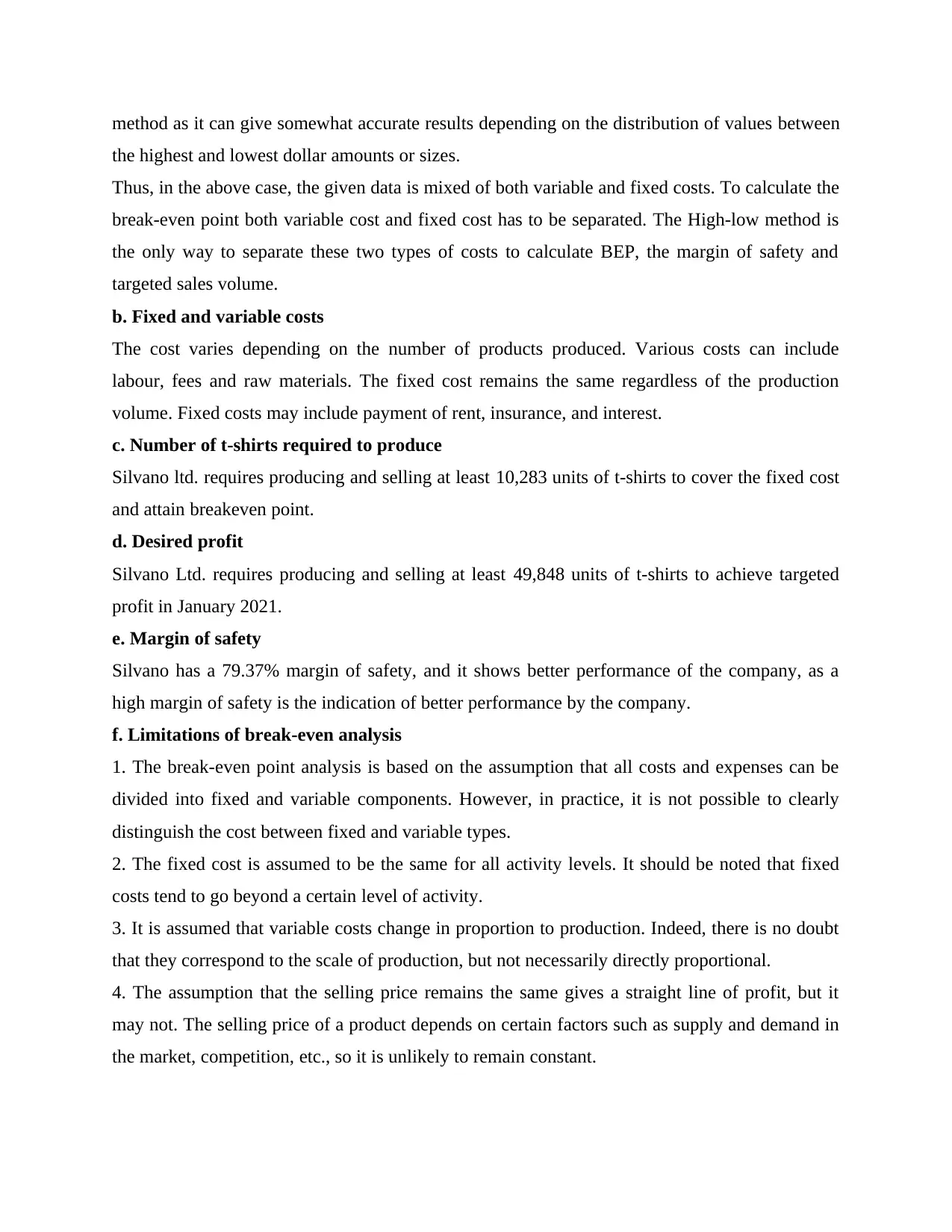
method as it can give somewhat accurate results depending on the distribution of values between
the highest and lowest dollar amounts or sizes.
Thus, in the above case, the given data is mixed of both variable and fixed costs. To calculate the
break-even point both variable cost and fixed cost has to be separated. The High-low method is
the only way to separate these two types of costs to calculate BEP, the margin of safety and
targeted sales volume.
b. Fixed and variable costs
The cost varies depending on the number of products produced. Various costs can include
labour, fees and raw materials. The fixed cost remains the same regardless of the production
volume. Fixed costs may include payment of rent, insurance, and interest.
c. Number of t-shirts required to produce
Silvano ltd. requires producing and selling at least 10,283 units of t-shirts to cover the fixed cost
and attain breakeven point.
d. Desired profit
Silvano Ltd. requires producing and selling at least 49,848 units of t-shirts to achieve targeted
profit in January 2021.
e. Margin of safety
Silvano has a 79.37% margin of safety, and it shows better performance of the company, as a
high margin of safety is the indication of better performance by the company.
f. Limitations of break-even analysis
1. The break-even point analysis is based on the assumption that all costs and expenses can be
divided into fixed and variable components. However, in practice, it is not possible to clearly
distinguish the cost between fixed and variable types.
2. The fixed cost is assumed to be the same for all activity levels. It should be noted that fixed
costs tend to go beyond a certain level of activity.
3. It is assumed that variable costs change in proportion to production. Indeed, there is no doubt
that they correspond to the scale of production, but not necessarily directly proportional.
4. The assumption that the selling price remains the same gives a straight line of profit, but it
may not. The selling price of a product depends on certain factors such as supply and demand in
the market, competition, etc., so it is unlikely to remain constant.
the highest and lowest dollar amounts or sizes.
Thus, in the above case, the given data is mixed of both variable and fixed costs. To calculate the
break-even point both variable cost and fixed cost has to be separated. The High-low method is
the only way to separate these two types of costs to calculate BEP, the margin of safety and
targeted sales volume.
b. Fixed and variable costs
The cost varies depending on the number of products produced. Various costs can include
labour, fees and raw materials. The fixed cost remains the same regardless of the production
volume. Fixed costs may include payment of rent, insurance, and interest.
c. Number of t-shirts required to produce
Silvano ltd. requires producing and selling at least 10,283 units of t-shirts to cover the fixed cost
and attain breakeven point.
d. Desired profit
Silvano Ltd. requires producing and selling at least 49,848 units of t-shirts to achieve targeted
profit in January 2021.
e. Margin of safety
Silvano has a 79.37% margin of safety, and it shows better performance of the company, as a
high margin of safety is the indication of better performance by the company.
f. Limitations of break-even analysis
1. The break-even point analysis is based on the assumption that all costs and expenses can be
divided into fixed and variable components. However, in practice, it is not possible to clearly
distinguish the cost between fixed and variable types.
2. The fixed cost is assumed to be the same for all activity levels. It should be noted that fixed
costs tend to go beyond a certain level of activity.
3. It is assumed that variable costs change in proportion to production. Indeed, there is no doubt
that they correspond to the scale of production, but not necessarily directly proportional.
4. The assumption that the selling price remains the same gives a straight line of profit, but it
may not. The selling price of a product depends on certain factors such as supply and demand in
the market, competition, etc., so it is unlikely to remain constant.
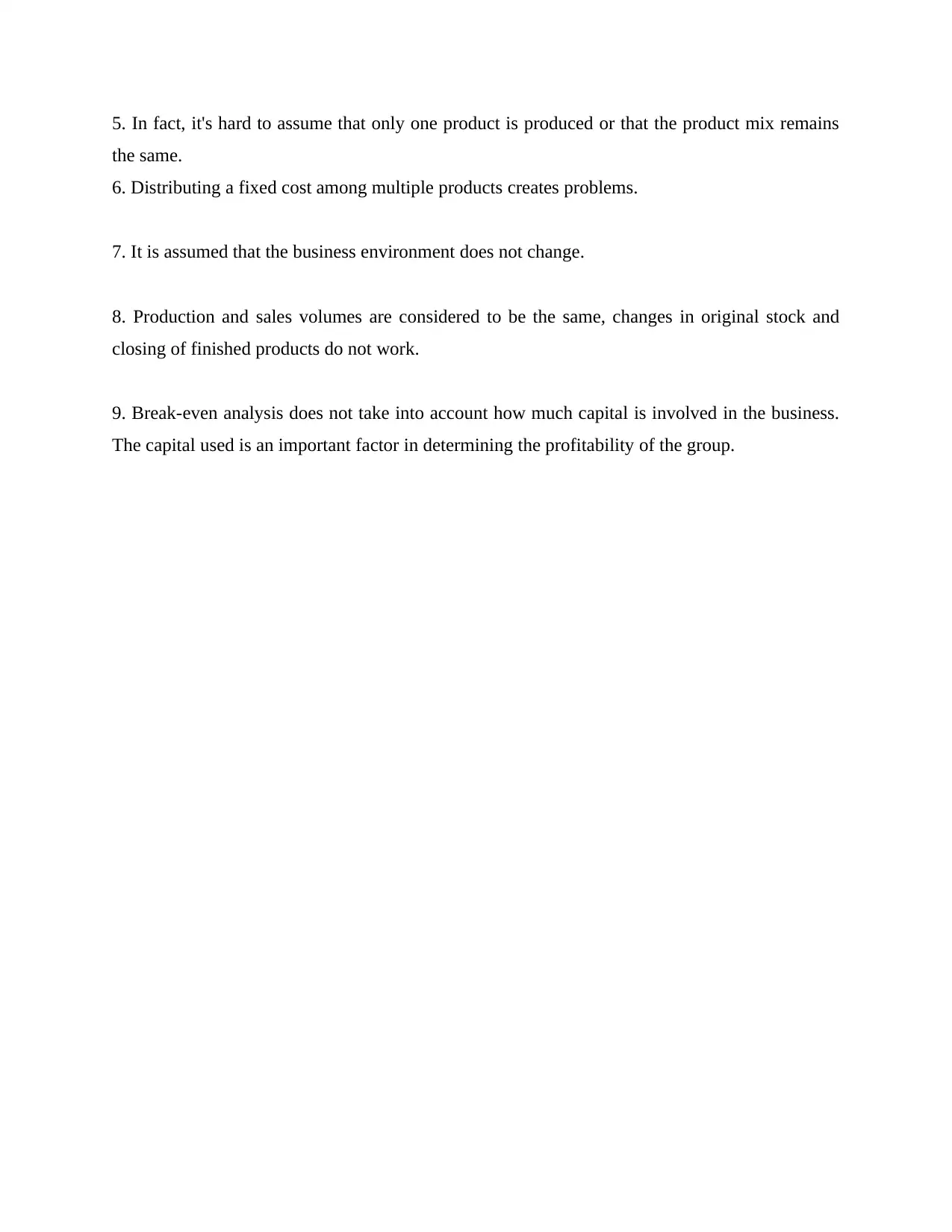
5. In fact, it's hard to assume that only one product is produced or that the product mix remains
the same.
6. Distributing a fixed cost among multiple products creates problems.
7. It is assumed that the business environment does not change.
8. Production and sales volumes are considered to be the same, changes in original stock and
closing of finished products do not work.
9. Break-even analysis does not take into account how much capital is involved in the business.
The capital used is an important factor in determining the profitability of the group.
the same.
6. Distributing a fixed cost among multiple products creates problems.
7. It is assumed that the business environment does not change.
8. Production and sales volumes are considered to be the same, changes in original stock and
closing of finished products do not work.
9. Break-even analysis does not take into account how much capital is involved in the business.
The capital used is an important factor in determining the profitability of the group.
⊘ This is a preview!⊘
Do you want full access?
Subscribe today to unlock all pages.

Trusted by 1+ million students worldwide
1 out of 12
Related Documents
Your All-in-One AI-Powered Toolkit for Academic Success.
+13062052269
info@desklib.com
Available 24*7 on WhatsApp / Email
![[object Object]](/_next/static/media/star-bottom.7253800d.svg)
Unlock your academic potential
Copyright © 2020–2025 A2Z Services. All Rights Reserved. Developed and managed by ZUCOL.





